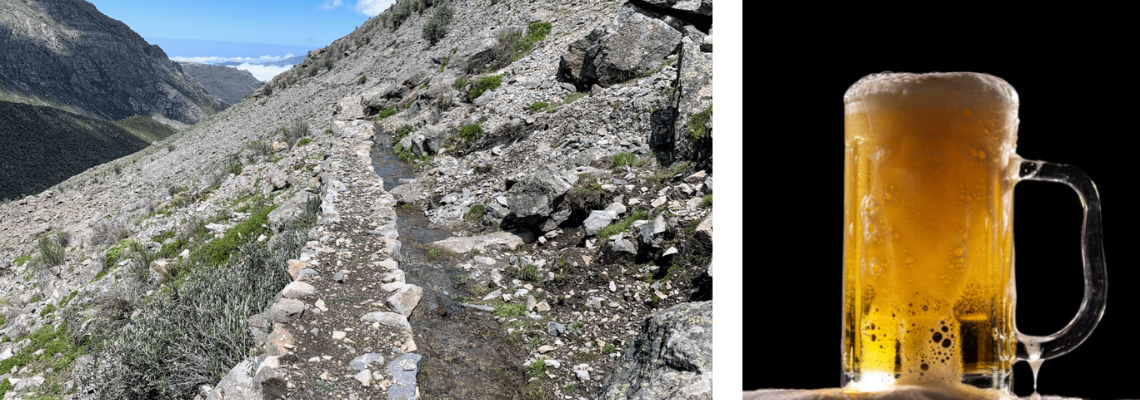The brewer restoring an ancient water system
Backus, a Peruvian beer brewer part of Anheuser-Busch InBev, is restoring an ancient water system to fight water scarcity in the area.
The 1,500-year-old water network
Peruvian brewer, Backus, is looking to restore an ancient water harvesting system in the Peruvian capital Lima, as part of its ambitious water stewardship goals in the region.
Lima is the world's second-largest city is located in a desert and faces tough water challenge. The capital only gets nine millimetres of rainfall each year for its 11 million population.
As a result, Peru has had to be clever when it comes to sourcing its water.
Back in 500 AD people living in the mountainous areas of Peru began using ancestral structures for water harvesting. The systems use a series of channels to filter rainy-season runoff from the mountains so that people living in the lowlands can use the water during the dry season.
“The restoration of the aquifers contributes directly to confronting the water crisis.”
These systems are known as amunas or mamanteos, and while they can be highly effective, they must also be maintained.
Unfortunately, over the millennia these ancient systems have fallen into ruin and are no longer able to harvest the vital water Lima needs.
Aquafondo: The Water Fund for Lima and Callao, was created to protect the water supply and says that climate change could cause a severe water shortage in the area within the next 10 to 15 years.
The fund approached Peruvian brewer, Backus to see if it could help restore the ancient water systems back in working order.
“Aquafondo presented us with the opportunity to work together to restore amunas, an ancient water-harvesting system in the area,” said Maria Atuesta Vegalara, regional sustainability manager for AB InBev's Middle Americas Zone.
“Aquafondo has been a great ally and partner in this mission because they have the technical knowledge to rehabilitate these amunas and strong relationships with the local community.”
Backus has to date invested $5 million to restore 32.5 km of amunas across the region.
“The restoration of the aquifers contributes directly to confronting the water crisis,” said Mariella Sánchez, executive director of Aquafondo.
“It will allow the lower part of the micro-basin to have greater water availability in the dry season, positively impacting the local livestock and farming.”
Capacity building to restore the amunas
How do you restore a 1,500-year-old water harvesting system?
In short, not easily. To restore these amunas, Aquafondo pairs technical expertise with the local communities’ ancestral knowledge of the terrain.
From this, the organisation has also developed awareness workshops in places where there is not yet extensive knowledge about using the ancestral channels for water conservation.
However, while the technical aspect of these systems can be overcome, there is one more challenge facing Backus and Aquafondo: Peru's stunning terrain.
"The greatest barrier is how remote these amunas are, as they're located so far up in the mountains," says Vegalara.
"Their remote location makes it very difficult to bring in construction materials and working on the channels is physically difficult because the altitude is high."
Another challenge is working around the natural climate. Navigating up the mountain is dangerous or even impossible in the rainy season, meaning rehabilitation is limited to the dry season, typically lasting from April through November.
“By teaching residents how to restore the amunas themselves, this knowledge stays in the community and will benefit future generations.”
But these are not challenges that are going to get in the way. So far, 15 km has been restored, with a goal of restoring the entire 67 km network of amunas by 2025.
Although the effort is well on its way, Backus says it cannot be achieved alone.
In addition to Aquafondo and The Nature Conservancy, other corporations have been invited to join the project, which was recognised with a Lighthouse Award from the Brave Blue World Foundation.
Over the next three years more than 400 residents from San Pedro de Casta, Huachupampa, Huanza, San Juan de Iris and Carampoma will be trained in operating and maintaining the amunas as part of a partnership with the German Development Cooperation.
“By teaching residents how to restore the amunas themselves, this knowledge stays in the community and will benefit future generations,” added Vegalara.
“When you think about sustainability, in the long run, the maintenance of the amunas by the communities is essential.”
Ambitious water stewardship goals
This project from Backus and AB InBev is a good example of companies that rely on water for their business looking to have a real impact on their water footprint.
Back in 2018, AB InBev set an ambitious water stewardship goal to bring measurable and improved water availability and quality to 100 per cent of its communities in high-stress areas by 2025.
This is a trend that is starting to catch on, even if it does not involve restoring ancient water harvesting technology.
Automotive manufacturing giant Volkswagen Group (VW) has reduced the amount of water used per vehicle through water recycling and more efficient manufacturing processes.
While US technology giant Google was recently recognised for its commitment to water stewardship across its campuses in US and Ireland.
Meanwhile, South African Breweries (SAB), also part of AB InBev has launched 'Project Popeye' to reuse brewery wastewater to help local businesses grow spinach using drip feed irrigation.
Related content
- VW taps the brake on water use
- Project Popeye: spinach helps close the loop on brewery wastewater
- Kodak gives snapshot of water reduction efforts in sustainability plans
Loading component...
We promise never to send you spam and you can unsubscribe at any time!
